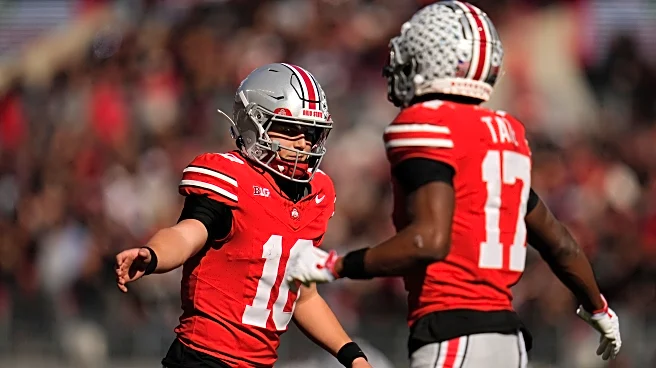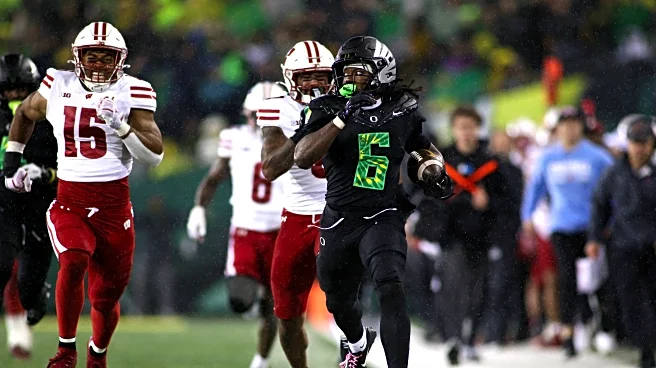It’s hard to believe that this Saturday’s game will mark only the fourth ever meeting between these two teams. I suppose it’s something of a testament to the old Conference system where the only way most
Pac12 and B1G teams ever met was at the Rose Bowl (and neither of these teams made it there very often). Iowa won the first meeting between these two schools 76 years ago in Kinnick (before it was called Kinnick) 34-31, but the last two meetings were a lot less competitive, with the Ducks beating up on the Hawkeyes 44-6 in 1989 (Iowa City) and 40-18 in their most recent meeting in 1994 (Eugene).
This one hits a little different though, because of what’s at stake. For #20 Iowa a win makes them a serious contender for an at large CFP bid (provided they also beat USC, MSU, and Nebraska), if they lose then all hope of a Playoff bid evaporates. For Oregon, a win keeps them in the running for a second straight B1G championship and a guaranteed CFP bid (provided they can get past the Gophers, #19 USC, and #23 Washington), a loss certainly drops them out of the top 12, but they could still sneak in as a 2 loss team in the B1G.
This is likely the biggest game Iowa has played since Penn State came to town in ‘21, and they’re home dogs for the first time this year, so let’s see what the numbers have to say.
Offense

Iowa – 317.9 ypg (132.6 passing, 185.3 rushing), 31.3 ppg
Oregon – 483.9 ypg (246.9 passing, 237.0 rushing), 41.3 ppg
Iowa’s offense under Tim Lester continues to show improvement. Mark Gronowski has shown a will to win like we haven’t seen in a while – and while he may only have 4 passing touchdowns, he’s found pay dirt 11 times on the ground and made the plays needed to win games. The Hawkeyes are grinding out yards on the ground at 185.3 per game, and they’re hitting 31.3 points per contest, which would have seemed like a fever dream just two years ago.
Oregon ranks 9th nationally in total offense, and those numbers tell you pretty much everything you need to know about the challenge facing Iowa’s defense. Quarterback Dante Moore commands a diverse and explosive attack that features multiple weapons. Moore has 1,772 passing yards with 19 touchdowns against just 4 interceptions, completing an impressive 71.4% of his passes.
The Ducks’ running game is equally potent, with Noah Whittington leading at 433 yards, followed by true freshman Jordon Davison at 352 yards. Oregon leads all of college football with 24 runs of 20+ yards, which is precisely the type of explosive play Phil Parker’s defense is designed to prevent.
ADVANTAGE: Oregon. The talent disparity is real, and the Ducks’ ability to hurt you in multiple ways makes them exceptionally difficult to defend.
Defense

Iowa – 234.9 ypg allowed (131.4 passing, 92.4 rushing), 13.1 ppg allowed
Oregon – 239.4 ypg allowed (124.6 passing, 114.8 rushing), 13.5 ppg allowed
Iowa has allowed the second-fewest yards in all of college football at 234.9 yards per game, ranking No. 6 in points per game allowed. This is Phil Parker’s defense playing at an elite level once again. Iowa ranked No. 1 in FBS in scrimmage plays of 30-plus yards allowed in each of the past three seasons, and that discipline will be tested like never before against Oregon’s explosive attack.
Iowa is tied for 4th in the country (with Oregon) allowing just 4.0 ypp, they’re 7th in yards per rush allowed, and 5th in passing yards allowed. Seriously, this defense has evolved into a unit with no glaring weaknesses. Senior DL Max Llewellyn leads Iowa with 6 sacks and 2 forced fumbles, he and Ethan Hurkett need to be in the backfield early and often.
Oregon’s defense is, essentially, just as good as Iowa’s, giving up only 4 ypp (as previously mentioned), though they are surrendering 3.3 yards per rush, to Iowa’s 2.6. That being said, they’re top 10 in scoring defense, and #1 in passing defense (which doesn’t bode well for an Iowa passing attack that struggles against mediocre defenses). All that being said, Oregon’s defense (unlike many other B1G teams) held Indiana to just 81 (Iowa allowed Indiana to run for 104), so you know that they can answer the bell against tough competition.
ADVANTAGE: Push. Both defenses are elite, and are going to make these offenses fight for every single yard.
Special Teams

Iowa – 43.7 ypp, 76.2% FGM (16/21), 27.8 ypkr, 25.7 yppr
Oregon – 42.2 ypp, 66.7% FGM (8/12), 22.8 ypkr, 8.4 yppr
LeVar Woods’ special teams unit has been Iowa’s calling card for years, though Drew Stevens has been less automatic than we’d like this season at ~76% on field goals, he seemed to be back in form against the Gophers. Rhys Dakin’s sophomore slump has had some bright spots (averaging 57.5 yards per punt against PSU), but he still needs to speed up his motion. Obviously the real weapon is Kaden Wetjen. His punt return TD against Minnesota was a thing of beauty, and attempts to kick away from him have not gone particularly well. Oregon will need to be smart about how they handle Wetjen, because he can flip field position or score in the blink of an eye.
Oregon isn’t going to wow anyone with their Special Teams but when you have the kind of weapons they do on offense, starting at the 25 doesn’t look so bad most of the time (as evidenced by the fact that they have only returned 4 kickoffs this season).
ADVANTAGE: Iowa. Wetjen is a legitimate game-changer, and field position battles could be critical in what projects to be a lower-scoring affair than Oregon is used to.
Numbers to Watch
5 – Dante Moore transferred in from UCLA and has had one hell of a season. He’s got elite arm talent and the poise to pick apart even the best defenses. Iowa needs to rattle him early.
11 – Mark Gronowski’s number and total number of rushing touchdowns this season (let’s hope that changes on Saturday)l. The two-time FCS national champion has finally transformed into the QB that we were all gaga over this summer. His mobility will be crucial against Oregon’s aggressive defensive front.
18 – Kenyon Sadiq is the kind of TE that Iowa fans are used to having on our line. He’s averaging 14.1 ypc, leads the Ducks in receiving touchdown, and is #3 on the team in receptions. At 6’3”, 245 he could give our linebacker’s a lot of headaches.
48 – Max Llewellyn leads the Hawkeyes with 6 sacks and has 2 forced fumbles to go with them. He’s been a real problem for opposing Olines (especially when you consider that they also have to deal with Aaron Graves inside and Ethan Hurkett on the other end) and will need to get in the backfield early, and often, if Iowa wants to slow down Moore.
61 – Oregon has the most scrimmage plays of 20-plus yards in FBS with 61. That’s the exact kind of explosive play Iowa’s defense is built to prevent. This will be the chess match within the game.
Lines
Point spread: Oregon -6.5
Over/Under: 40.5
The public loves Oregon’s offensive firepower, but this feels like the kind of game Iowa can keep close at Kinnick. If the forecast holds (48 degrees and rain) this may be the coldest game some of these Ducks have ever played, so the under feels like the play here. The Hawks are going to do everything they can to slow the game down, and with two weeks to prepare, Phil is going to have the defense ready. Oregon’s offense hasn’t experienced anything like Kinnick Stadium’s atmosphere yet, and if Iowa can pin the Ducks deep and force them into long, methodical drives instead of the quick-strike touchdowns they’re used to, the Hawkeyes have a real shot.
This is Iowa’s chance to get the statement win that slipped through their fingers against the Hoosiers. Oregon is talented, well-coached, and has CFP aspirations. But the Hawkeyes have the defense to frustrate the Ducks, and if Gronowski can move the chains on the ground, Iowa can control the clock and keep this game in the 20s.
As always, GO HAWKS!!!












